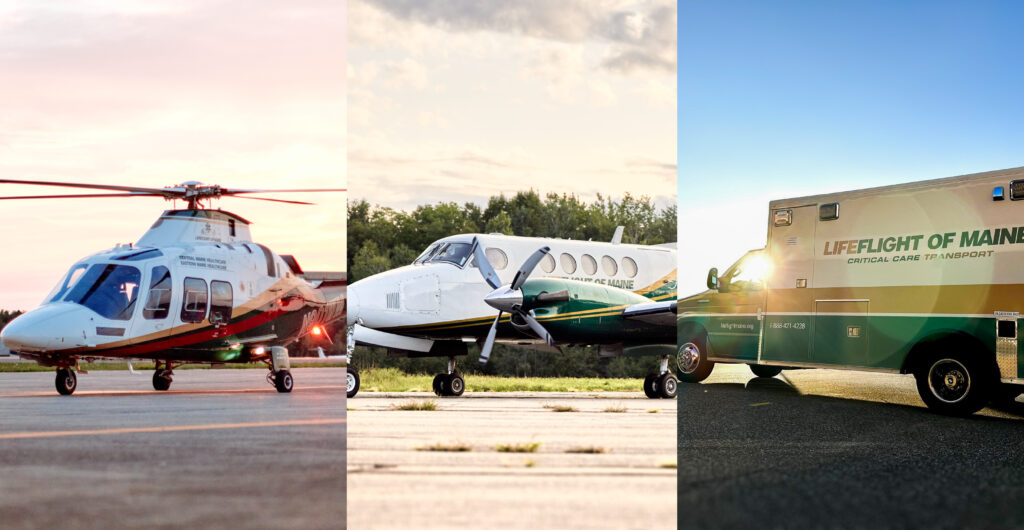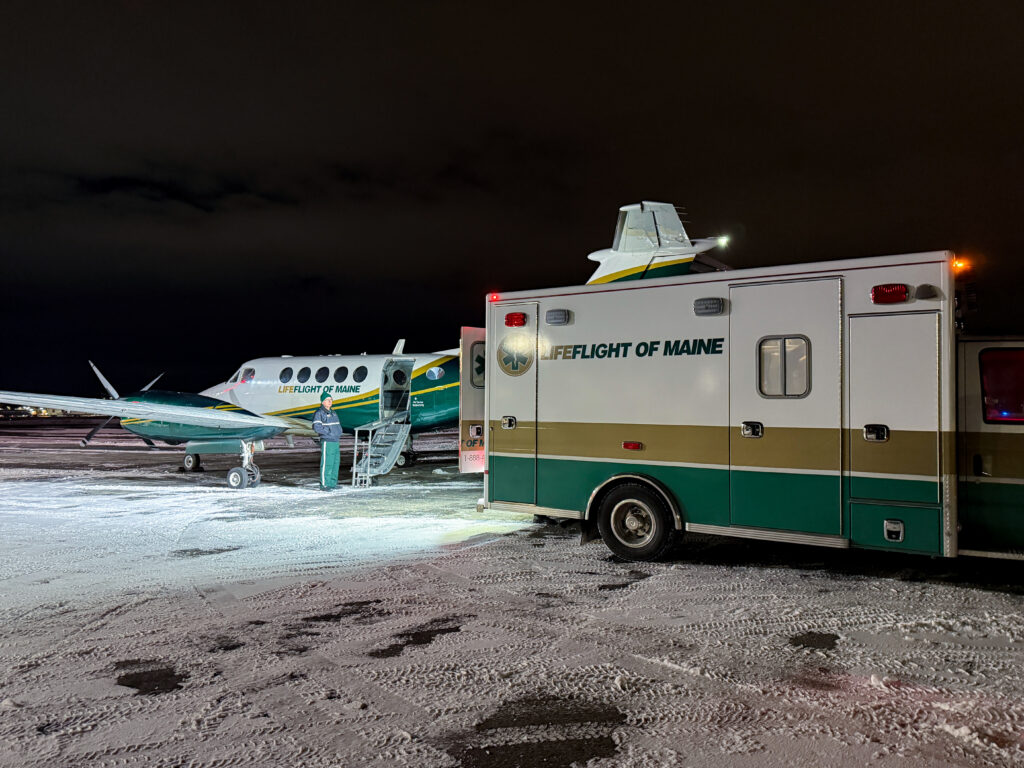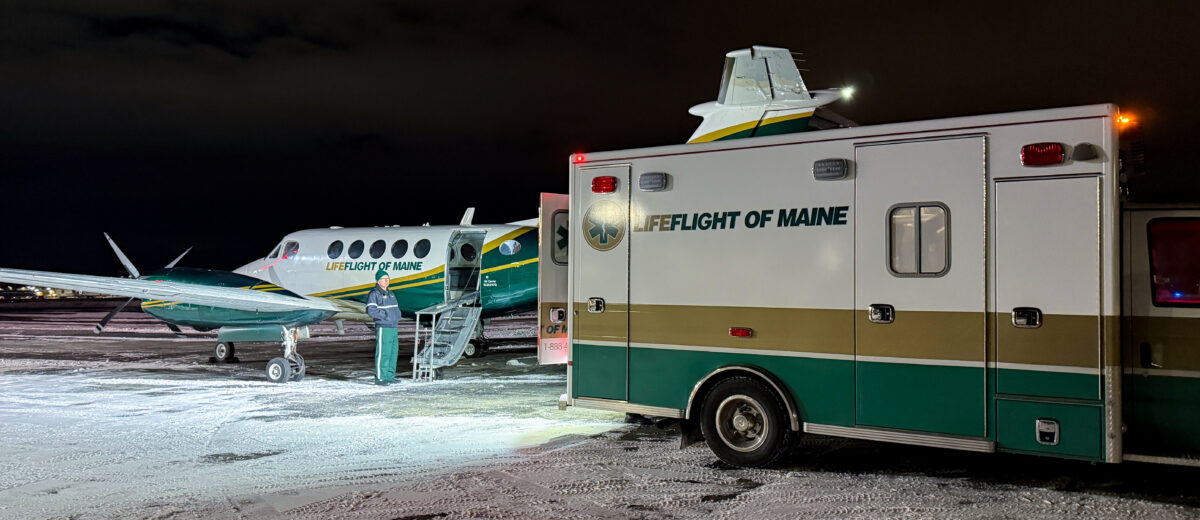Three Modes of Transport. One Critical Care Team.
LifeFlight of Maine’s mission is to provide critical care and medical transport to anyone across the State of Maine, when and where they need it. Every decision and every action taken is designed to accomplish both of those objectives as safely and effectively as possible.
“Critical care” is a technical term that encompasses a broad swath of sophisticated medical procedures, but it essentially refers to the medical care provided to a person whose condition is life-threatening. “Medical transport” is more straightforward. It involves moving a patient from one place to another. It is not specific to a particular vehicle, or type of vehicle.
LifeFlight utilizes three modes of transport: helicopter, airplane, and ground ambulance. In each, the standard of care is the same. LifeFlight provides ICU-level critical care that patients all across Maine rely upon in their moment of need. It uses different modes of transport, because each has its own advantages and limitations based on the situation, and providing safe, reliable care is the core of LifeFlight’s mission.

Speed
LifeFlight’s Leonardo 109 helicopters are fast, with a cruising speed of about 165 miles per hour, but they are not as fast the airplane, which cruises at nearly 350 miles per hour.
Fuel Load
The airplane can fly from Fort Kent to Philadelphia without refueling along the way. A helicopter flying from Bangor to Boston must stop to refuel en route.
Landing
The helicopters can land just about anywhere, so long as the area is 100 feet by 100 feet, mostly flat, and free of trees and other obstructions. Nearly all of Maine’s hospitals have helipads, so LifeFlight’s helicopters can transport a patient from the front door of one facility directly to the rooftop of another. The airplane needs a runway that is at least 2,800 feet long. A patient transport by airplane always includes a ground leg between the hospital and the nearest suitable airfield, and that ground leg adds time to the trip. Minimizing “out-of-hospital time,” or the amount of time a patient spends in transport, is critical in many cases.
For example, the flight from Presque Isle to Bangor is about 30 minutes shorter by airplane than by helicopter. However, it takes about 20 minutes to transport the patient by ground from Northern Light AR Gould Hospital to the runway in Presque Isle, and then another 15 minutes to transport the patient from the runway at Bangor International Airport to Northern Light Eastern Maine Medical Center (EMMC). The helicopter can fly the patient directly from the helipad at AR Gould to the helipad at EMMC, so the total out-of-hospital time is five minutes shorter when the patient is transported by helicopter.
Conversely, the flight from Presque Isle to Portland is nearly 60 minutes shorter by airplane than by helicopter, which must stop to refuel in Bangor. So, when transporting a patient from AR Gould to Maine Medical Center (MMC), the airplane reduces out-of-hospital time for that patient by 25 minutes (after accounting for the ground legs), making it the preferred mode of transport between those two hospitals.

Traveling by ground is, of course, considerably slower, but not all LifeFlight patients need the speed of an aircraft. Many patients in Maine can be transported only by LifeFlight because they need to maintain the same ICU-level of care during transport, but their condition is less affected by out-of-hospital time. For these patients, moving by LifeFlight ambulance may be the best option. It provides safe and reliable transport from one medical facility to another, while keeping the LifeFlight aircraft in service for other patients in Maine for whom out-of-hospital time is critical.
Who decides, and how?
So, who decides which LifeFlight vehicle responds to a call for help, and how? Usually, it’s the air communications specialist at MedComm, LifeFlight’s dispatcher. As an integral part of the crew, the communications specialist (referred to as the “comm spec”) is the first and primary layer of triage. The comm specs work from the MedComm dispatch center on the second floor of LifeFlight’s Bangor hangar. They coordinate communications for transport operations, and they dispatch LifeFlight medical crews. When a call comes in, the comms spec references the Transport Asset Selection Criteria, or TASC chart.
There is a row on the TASC chart for every hospital in Maine and a column for the six major medical centers to which LifeFlight is most likely to transport a patient: Eastern Maine Medical Center in Bangor, Maine Medical Center in Portland, Central Maine Medical Center in Lewiston, and the handful of major medical centers in Massachusetts and New Hampshire. The comms spec finds the row for the sending facility and the column for the receiving facility. In the cell where they meet on the chart, LifeFlight assets are listed in order of priority. The chart was developed through analysis of years of flight and geographic data. For example, for AR Gould Hospital to EMMC, LifeFlight 1, the helicopter team based in Bangor is the preferred mode of transport, with LifeFlight 3, the Bangor-based airplane crew as secondary. For AR Gould to MMC, the order of preference is reversed.
The TASC chart identifies the best available transport asset for the patient at any given time. If all conditions were perfect all the time, there would be no need for the chart. All LifeFlight vehicles would be in service and available. Only one request for help would be received at a time. The skies would be blue, the temperatures far above freezing, and the winds blowing from the southeast at a pleasant five miles per hour. But this is Maine.
That warm, sunny day is reserved for the summer month, when the population of the state swells with seasonal residents and visitors, and the calls for help begin to stack up. If a LifeFlight team is already transporting a patient when a call is received, the comms spec will move through the TASC in order to the next available asset.
Colder weather brings icing conditions. When there’s visible moisture in the air (i.e. clouds) and temperatures reach freezing, ice can build up on aircraft wings, which is incredibly dangerous for aircraft without de-icing capability. Most helicopters, including LifeFlight’s, cannot fly in icing conditions.
LifeFlight’s airplane, however, is equipped with de-icing technology. So, when temperatures dip below freezing and the cloud ceiling is low enough to ground helicopters, the airplane can still reach patients in need.
At some point, though, Maine’s weather invariably becomes inhospitable to aviation of any kind, and so, fitted with snow tires, LifeFlight’s ambulances hit the road to transport critically ill or injured patients.
These assessments and decisions are made in real time by experienced comm specs, pilots, vehicle operators, and clinicians who have spent years transporting patients across Maine. Research and data analysis provide strong guidance for their decision-making, but no situation ever fits a template perfectly. LifeFlight’s mission is, and has always been, to provide the highest level of medical care available while maintaining uncompromising safety standards for patient care and transport operations. Ultimately, in the most challenging circumstances, the decision is made based on maintaining the safety of all involved and the asset that would give the patient their best chance possible.

Photo courtesy of flight nurse Veronica Marzonie.

